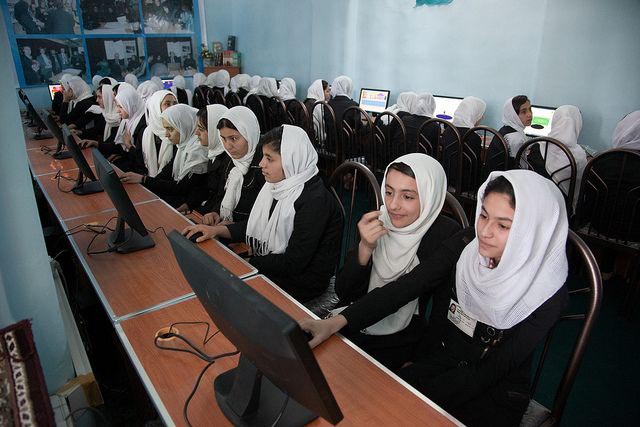In the past, learning and education simply meant teacher-center methods mainly face-to-face lectures, reading books or printed handouts, taking notes and completing assignments generally in the form of answering questions or writing essays. In short, education, learning and teaching were considered impossible without a teacher, books and chalkboards. Today, education and training have taken a whole new meaning. Computers are an essential part of every classroom and teachers are using DVDs, CD-ROMs and videos to show students how things work and operate. Students can interact with the subject matters through the use of such web based tools and CD-ROMs. Students are growing up in a digital world. Using digital devices is a huge part of their everyday experience out of school. Through internet they have access to a wide wealth of digital information, content and resources.
In addition to computers, modern schools and colleges are using new methods of technology to enhance the learning experience; these include digital television channels, digital radio and sophisticated forms of communication technology. Digital radio and television allow students to access a wealth of different channels which cover a vast range of different subjects including languages, science, history and geography to name just a few. Children are used to new technology as they have grown up with it; it is therefore undoubtedly beneficial that they have the option to use it, to increase their learning capacity and pursue their interests. Educational programmes and podcasts are now widely available to download on computer or MP3 player; this makes education more modern and multi-faceted.
The role of technology in the field of education is four-fold: it is included as a part of the curriculum, as an instructional delivery system, as a means of aiding instructions and also as a tool to enhance the entire learning process. In fact, education has gone from traditional passive and reactive to interactive, aggressive and modern. It is essential in corporate and academic settings. In the past, education or training is used to help workers do things differently than they did before. In the latter; education is geared towards creating curiosity in the minds of students. Thus, Research has shown that students learn best when they are engaged. Through the use of technology, students can become active participants as opposed to passive ones they simply receive instructions or information.
Technology allows distance learning: Perhaps the greatest impact of technology in the field of learning is its ability to help several people learn simultaneously from different locations. Learners are not required to gather at a predetermined time or place in order to learn and receive instructions and information. All one needs is a computer connected to a modem (or with a CD drive); these tools can literally deliver a ‘classroom’ at the homes and offices.
Technology allows group learning: There are naysayers who argue that distance learning of this sort cannot help students receive the support of traditional group-based learning. For proving this theory wrong, technology has helped provide distance learners with online communities, live chat rooms and bulletin boards. All these allow students to collaborate and communicate even though they are isolated in their own space.
Technology allows individual pacing: Multimedia tools, on-line and CD-ROM based training have helped eliminate the need for an instructor-based lesson plans. Students who grasp concepts faster proceed and move along, without being held back by ones who need more time and help for learning. Such individual pacing is beneficial to all.
Technology helps lower training costs and increases productivity: Another benefit of using technology to reach many students in shorter time is lowering training costs. Corporate and academic Institutions can reduce their costs of delivering lessons to students on a per-student basis. Moreover, technology produces quantifiable results and allows students to put into practice this information quickly and with better results. Through the use of technology, students can considerably save time and increase their productivity. Both these points justify the higher costs of advanced technological tools.
Roadblocks in the use of technology in learning: Naturally, for education technology to have a positive impact on students, it should be designed and prepared well. Tools used for disseminating information must be developed with students in mind. There are also factors like lack of computer/technology literacy to be considered. Schools and businesses must bear in mind that education technology is simply a tool and its success depends largely on the amount of planning that goes into it. Using education technology can be a right choice as long as all such factors are considered.
Home » Opinion » Role of Technology in Educational System
Role of Technology in Educational System
| Mohammad Zahir Akbari

